| Columns Retired Columns & Blogs |
Slim Devices Squeezebox WiFi D/A processor Measurements
Sidebar 3: Measurements
While measuring the Squeezebox, I used it, powered by its switch-mode power supply, to play 16-bit test-tone files on my Mac mini via an Airport Express WiFi hub. With the SB's volume control set to its maximum ("40"), the output level from its RCA jacks with a 1kHz tone at 0dBFS was 1.845V, or 0.7dB below the CD standard's 2V RMS. The Squeezebox preserved absolute polarity— ie, was noninverting—and the output impedance was a low 223 ohms at midrange and bass frequencies, rising to 549 ohms at 20Hz. The volume control operated in accurate 1.25dB steps. All the subsequent measurements were performed with the Squeezebox's volume control bypassed.
The Squeezebox's frequency response (fig.1) showed a slight shelving-down at low frequencies that might just be audible given the wide range covered. Channel separation (not shown) was superb, at better than 110dB in the midrange, though I had to experiment with the grounding of the Audio Precision test set to get this low a figure.
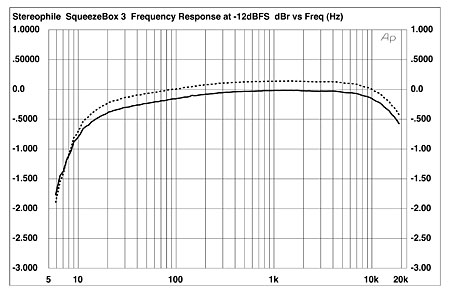
Fig.1 Slim Devices Squeezebox, frequency response at –12dBFS into 100k ohms (right channel dashed, 0.5dB/vertical div.).
Fig.2 shows the spectrum of the Squeezebox's analog output analyzed with a swept 1/3-octave bandpass filter while it decoded dithered data representing a 1kHz tone at –90dBFS. The traces are free from both power-supply and harmonic-distortion spuriae and peak at –90dBFS, suggesting good DAC linearity. The right-channel trace has some energy peaks centered on 9kHz and 18kHz, but these are low in level. Both channels also have a small energy peak evident at 30Hz, and the overall noise floor is 10–20dB higher in the midrange and bass than with the best 16-bit playback devices.
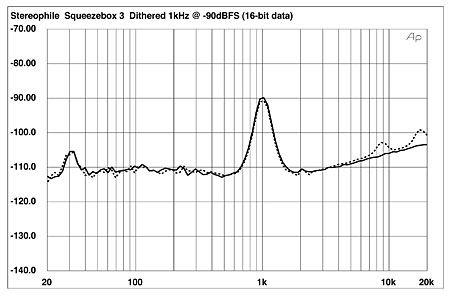
Fig.2 Slim Devices Squeezebox, 1/3-octave spectrum with noise and spuriae of dithered 1kHz tone at –90dBFS, 16-bit data (right channel dashed).
Repeating the spectral analysis over a wider 200kHz bandwidth and driving the Squeezebox with data representing a –1LSB DC offset gave the spectrum shown in fig.3. The small peak at 30Hz is again evident, as are the right-channel spuriae at 9kHz and 18kHz. But the most prominent feature of this graph is the large rise in noise above the audioband, this due to the noiseshaping used to achieve 16-bit resolution in the DAC chip.
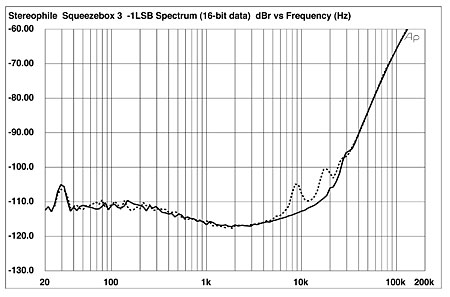
Fig.3 Slim Devices Squeezebox, 1/3-octave spectrum with noise and spuriae of –1LSB, 16-bit data (right channel dashed).
The DAC has low linearity error down to below –90dBFS (fig.4), though there is more noise apparent in this graph than is usual with 16-bit devices. Even so, the Squeezebox's reproduction of an undithered tone at exactly –90.31dBFS (fig.5) is pretty good, the noise not obscuring the three voltage levels described by this signal.
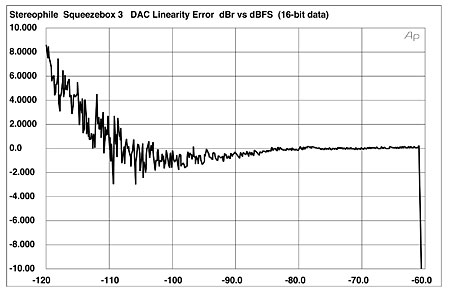
Fig.4 Slim Devices Squeezebox, right-channel departure from linearity, 16-bit CD data (2dB/vertical div.).
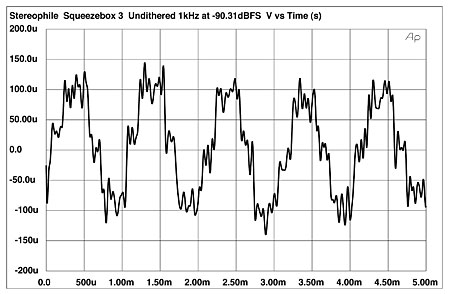
Fig.5 Slim Devices Squeezebox, waveform of undithered 1kHz sinewave at –90.31dBFS, 16-bit CD data.
The Squeezebox offered very low levels of harmonic distortion. Fig.6, for example, is an FFT-derived spectrum of its output while it drove a full-scale 1kHz tone into a low 4k ohms load. The measured THD (actual sum of the harmonics) was just 0.0017% left and 0.0009% right, with the second harmonic the highest in level at –98.2dB left and –103dB right, and no higher-order harmonics visible above the noise. The noise floor in this graph is about 5dB higher than is usual with this measurement, though it is dominated, I suspect, by the analyzer's own noise. When I repeated this spectral analysis with the dithered 1kHz tone at –90dBFS that I'd used to plot fig.2, the left channel performed very well, with no significant spuriae poking their heads above the noise floor (fig.7). The right channel, however, produced a high level of second-harmonic distortion (the vertical red line at 2kHz) and a cluster of spectral lines in the 9kHz region. Peculiar.
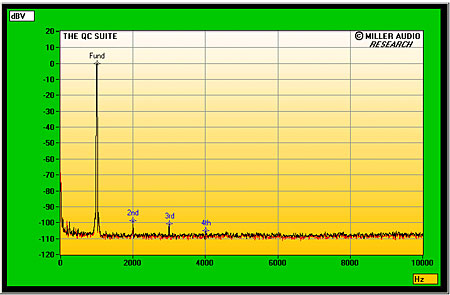
Fig.6 Slim Devices Squeezebox, spectrum of 1kHz sinewave at 0dBFS into 4k ohms, DC–10kHz, 16-bit data (linear frequency scale).
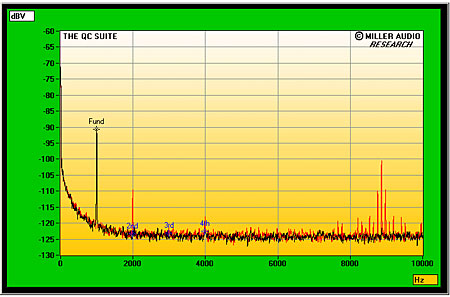
Fig.7 Slim Devices Squeezebox, spectrum of dithered 1kHz sinewave at –90dBFS into 4k ohms, DC–10kHz, 16-bit data (linear frequency scale).
The Squeezebox did well on the high-frequency intermodulation test, producing just 0.006% of difference product when fed an equal mix of 19kHz and 20kHz tones, the combined waveform peaking at 0dBFS (fig.8). However, with both this and the jitter test I got some occasionally anomalous results due to the high-frequency tones changing level very slightly. I suspected that this instability was a WiFi network problem—except that it happened once when I used a wired Ethernet connection from the Mac mini to the Squeezebox. Powering down the unit fixed the problem every time.
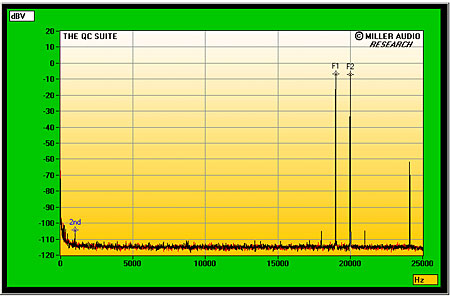
Fig.8 Slim Devices Squeezebox, HF intermodulation spectrum, 19+20kHz at 0dBFS peak into 4k ohms, DC–24kHz, 16-bit data (linear frequency scale).
Finally, I assessed the Squeezebox's rejection of word-clock jitter with the Miller Audio Research Jitter Analyzer, a software solution that runs on a host National Instruments PCI card. The diagnostic signal fed the device under test comprises a high-level tone at 11.025kHz (Fs/4) over which has been laid the LSB toggling on and off at 229.7Hz (Fs/192). Because both signals are exact integer fractions of the sample rate, there will be no quantizing distortion, and all artifacts in the tested device's analog noise floor will be the result of its own misbehavior. Fig.9 shows a narrowband, FFT-derived spectral analysis of the Squeezebox's analog output while it decoded this signal. The central vertical line is the 11.025kHz tone; it suffers from very little spectral spreading, which is good—but, as mentioned above, occasionally this wasn't the case. The spectral lines indicated with red numeric markers are sidebands at 229Hz and its harmonics. These are relatively low in level. The calculated jitter level was 321 picoseconds peak–peak, which is low. Most of this comes from sidebands of unknown origin (purple numeric markers).
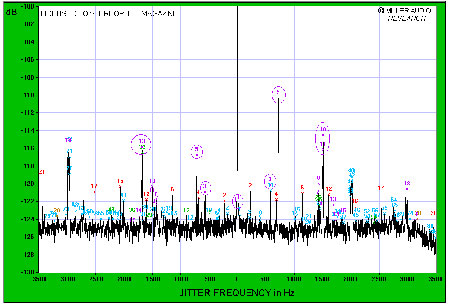
Fig.9 Slim Devices Squeezebox, high-resolution jitter spectrum of analog output signal (11.025kHz at –6dBFS sampled at 44.1kHz with LSB toggled at 229Hz), 16-bit data. Center frequency of trace, 11.025kHz; frequency range, ±3.5kHz.
Considering its low price and the fact that it uses a minuscule wall-wart power supply, the Squeezebox measures very well. Its noise floor is higher than that of good CD players, but the excellent jitter rejection came as a welcome surprise.—John Atkinson
- Log in or register to post comments




































